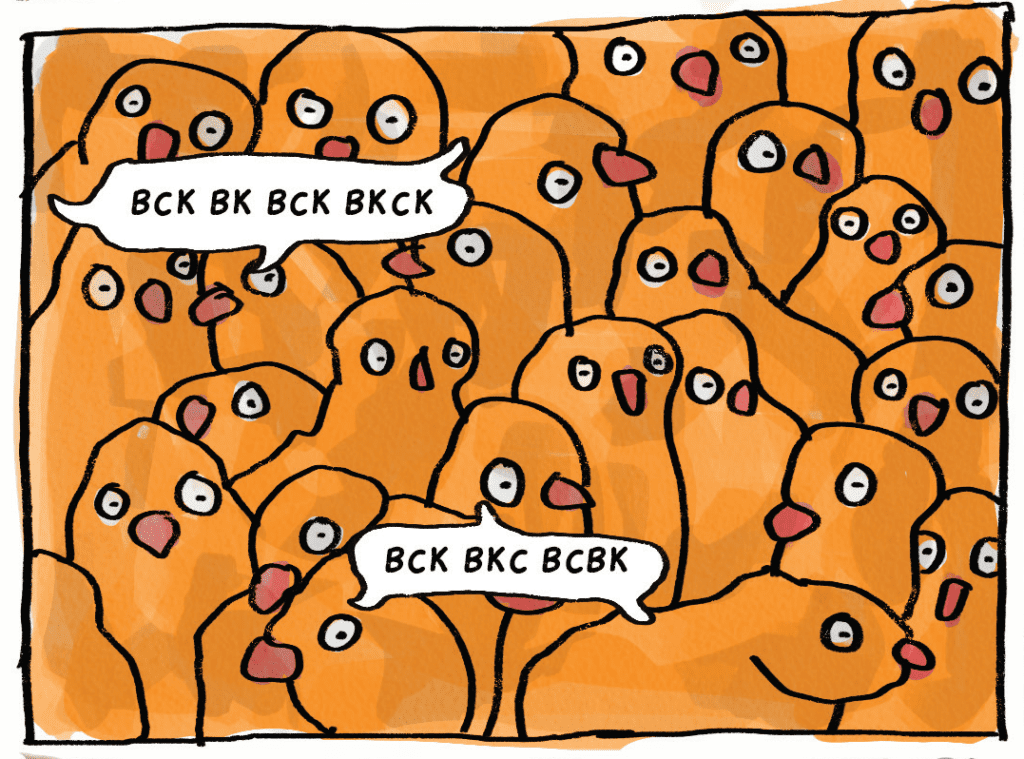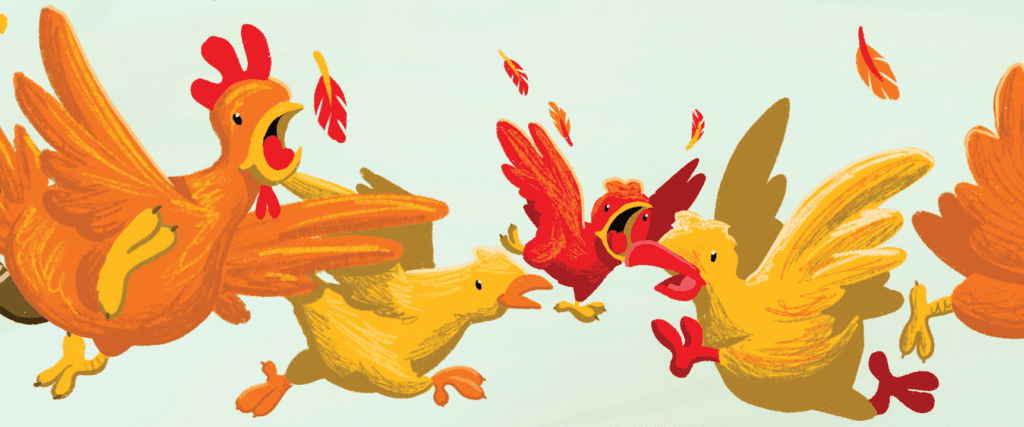Were you ever in a writing class and teacher said “I want you to write a story based on the following phrase…”?
It would appear that somebody in the Reverie stable has posed that very challenge. The phrase in this case is “Too many chooks”. The result is Vamoose #1, a collection of stories by various creators based on that premise.
As with The Devil’s Toilet, also released by Reverie, this is a book that in no way takes itself seriously. We find five very different stories by four creative teams determined to have their own kind of fun with a simple, silly theme.
One too many chooks: What Are Ya, Chicken?

The first tale of poultry plenitude is by Rob ‘Spedsy’ Lisle. What Are Ya, Chicken? Begins with the main character, Leeroy Bescotty (“you can call me biscuit”) boarding a plane. He’s not happy about this, nor about having his swords taken from him. In fact, he’s just not happy, as he freely admits.
Although he’s doing his best to follow the advice of his shrink to address this character flaw, what Leeroy finds on the plane is not at all helpful. Suffice to say that the chicken theme is played out to the full. A most unusual fight ensues, resulting in the destruction of the aircraft and the rather fortuitous reunion of Leeroy with his swords.
These are then put to good use and our unlikely hero prevails. Now, winning a fight while falling to your death from an aeroplane is not really a strong win. However, a plot twist in the final panel gives hope for our hero, paves the way for a sequel in Vamoose #2 and adds a new twist to the “too many chooks” tag.
Drawn in a simple, cartoony style, Lisle’s characters – even the chooks – clearly convey the emotional range required by the tale. Action scenes are dramatic, with effective use of layout variation. Scripting strikes a neat balance, with just enough exposition to complement the art and a nice assortment of mildly corny chicken jokes. The cliffhanger ending leaves us wanting more.
Two too many chooks: Backyard Poule

Nick May is the creator of our second helping. Backyard Poule is both a clever little pun and a whimsical tale about the difficulties of feeding on free range chicken.
We begin with the two main characters pondering their hunger and deciding that free range is the answer. After hunting in vain for some time, our two protagonists mistake a petting zoo for a self-serve free range farm. This farm, of course, has too many chooks.
Our heroes nevertheless make their selections. The farm manager, awake to their plan, intervenes and suggests they try her hypno-rooster instead. This leads to a rather unusual conflict and a chase across the skyline of Richmond. Our heroes prevail and – with just enough time for a cute little nod to Blade Runner – satisfy their craving.
The style of this piece is again cartoon-like. The designs of the characters and their movements are exaggerated in such a way that the reader can almost hear a farcical soundtrack and the voices of favourite comedy cartoons of the past. Dialogue is sparse and subservient to the art, which fits the art style perfectly. This is a visual story.
Three too many chooks: My Son, Steven

A tasty morsel by Millie Holten, My Son, Steven is a one-page gag that is best served unspoiled. Suffice to say it hinges on the fact that all chooks look alike – perhaps even to each other.
Purely a comedic sketch, this piece relies on simple but direct art and just the right amount of dialogue to deliver its punchline, leaving the book’s theme unstated but obvious to the reader.
Four too many chooks: The Great Chicken Coup

For the fourth course, Haydn Spurrell offers The Great Chicken Coup, a text piece with framing illustration by Emily Grace. Another tale with a nicely punny title, it attempts to answer a profound and ancient philosophical question about chickens.
The story is part school science project report and part rural detective story, with a dash of animal liberation and a generous helping of humour. The ending will not be expected by most but wraps up the tale nicely.
The writing on this piece cleverly interleaves the two parallel narratives, bringing them together for the comical climax and surprise twist ending. The art in this case is principally for decoration but nicely conveys a key scene.
Five too many chooks: Cock-a-Doodle-Doom

In Cock-a-Doodle-Doom, Peter Wilson has dished up what we all must surely admit was almost inevitable – a post-apocalyptic tale of zombie chooks. In scary black and white, this tale tells of the Bok-ing Dead, somehow evolved from the common chook and relentless in their quest for “graaaaiinnss…”. And humans.
Did I say post-apocalyptic? Nah. Humanity ends in this one. As does the comic, to paraphrase the final line.
Grittily drawn and earnestly told, much of the humour of this piece comes from its parodying a very popular genre. There are however, a number of nicely comical images to spice up the humour just a little more.
Final thoughts
Five stories. Five very different takes on a simple theme. What better way to showcase the amazing diversity of creativity out there? Each story takes the simple idea of “too many chooks” and explores it in a unique and entertaining way. I expect the teacher who posed the assignment will be handing out high marks all round.
Not only do we have five distinctly written tales, each with a unique slant on the theme. We also have five unique artistic styles bringing the stories to life. From the whimsical cartoonery of the stories by Lisle and May, through the simple directness of Holten’s one-pager, the evocative panel illustration by Grace in Spurrell’s text piece to the grittily satirical style of Wilson’s tale – each story matches writing and art perfectly to convey the desired tone.
If you are looking for profound truths about the human condition, you may wish to look elsewhere, although this book has its fair share of keen observations. But if you want to be entertained and impressed by a pleasingly varied cross-section of Aussie talent, pluck this book from the shelves and have a read.
